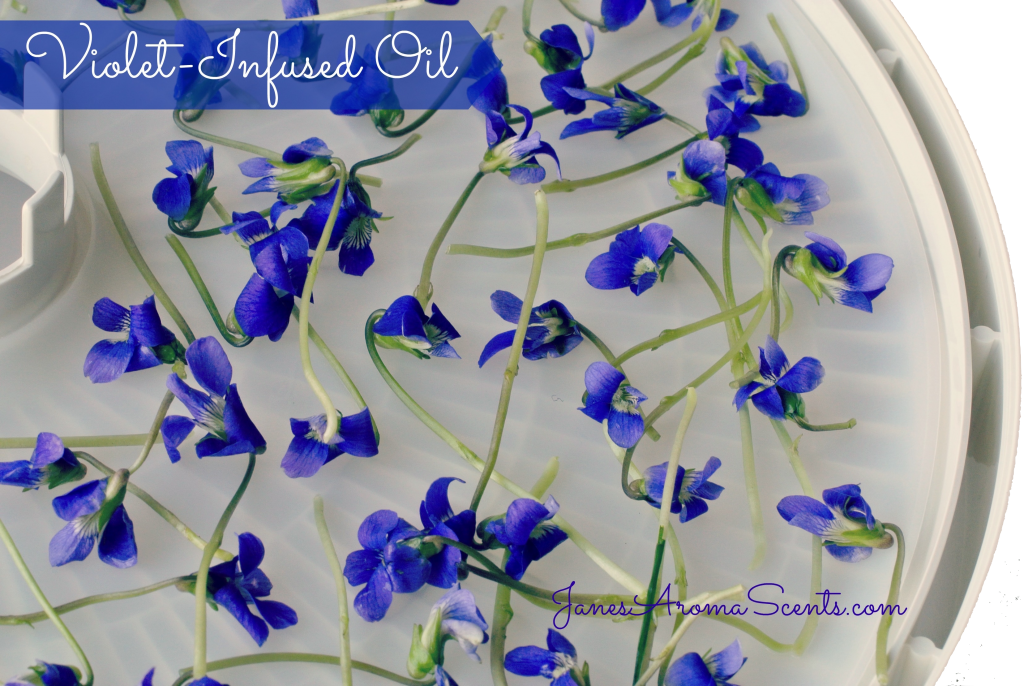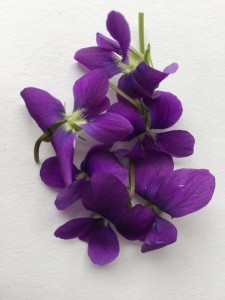Make Your Own Violet Oil
 Over the last week, I’ve seen them peeping from behind their heart-shaped leaves. Little flower faces shyly stretching up to the sky. Could there be a sweeter flower than violets?
Over the last week, I’ve seen them peeping from behind their heart-shaped leaves. Little flower faces shyly stretching up to the sky. Could there be a sweeter flower than violets?
Certainly one of my favorites, violets are a joy to behold when spring arrives. Their aroma fills the air when warmed by the spring sunshine. They’re so lovely I can’t help but think of this quote from L.M. Montgomery in Anne of Green Gables,
“Do you think amethysts can be the souls of good violets?”
Beauty and All That?
 Besides being beautiful, violets can add variety to life as we candy, infuse, tincture, press, and otherwise use them in ways that are a delight. To be clear, I am talking about Viola odorata, not African violets, which are not edible and a different plant entirely.
Besides being beautiful, violets can add variety to life as we candy, infuse, tincture, press, and otherwise use them in ways that are a delight. To be clear, I am talking about Viola odorata, not African violets, which are not edible and a different plant entirely.
This spring I’ve decided to gather violets from my yard to make my own infused oil. They are anti-inflammatory, antiseptic, and antifungal, which make a potent healing oil suitable for use right out of the bottle or in creams, lotions, and salves.
Their leaves also contain Vitamin C and can be infused along with the flowers for a hot or cool tisane. But today I’d like to focus on making an herbal oil with violet flowers and leaves. For your oil, you can use either fresh or dried material. (Note: garlic, cottonwood, St. John’s Wort, and mullein flowers should always be infused fresh).
Preparing the Violets
If you’re using fresh, we need to address the topic of how to prepare them for infusion. Herbalists handle this differently. Some herbalists wash fresh herbs before using, some don’t. I think it depends upon several factors:
- Where have the herbs come from? If they’re from your own yard and you know you didn’t use any chemicals on them, you may feel ok not washing them. Do you have pets (or neighbors’ pets) that may have contaminated them? That also plays into the equation.
- Will you be selling your products or giving them away? Then for your own protection and peace of mind, I would wash them.
- If you’ve purchased them elsewhere and don’t know how they were grown/handled, wash them.
To wash them, gently spray off if they are not too dirty, or you can immerse in a cool water bath with a drop or two of organic veggie/fruit cleaner added, swish them around or soak for a few minutes if very dirty, rinse off, and pat dry. Once you have done this, you now need to let them fresh wilt for 24-48 hours so that the moisture evaporates; if you don’t do this, you could likely end up growing mold in your oil. They will become limp but not totally dry when fresh wilted. Thinner plants will dry wilt faster than thicker, so keep an eye on them. Some plants may wilt in just 6-8 hours.
Choose Your Oil
Next, choose your oil. If you’re using the oil for medicinal or culinary purposes, organic olive oil is your best choice. If you will be using the oil for beauty products, you may want to try organic sweet almond oil, organic coconut oil (warm infusions only), jojoba, sesame, or sunflower.
Add your fresh-wilted or dried violet flowers and leaves to a dry, sanitized glass jar and cover with oil so  that the plants are completely submerged with one to two inches of oil over the top. Cap. If you are using fresh wilted and are still concerned about moisture, cover the jar with a thick layer of cheesecloth instead of the cap and rubber band it to let any moisture evaporate. Let sit out for about 2 weeks in a warm spot. You can let it sit in the sunshine for a solar oil, as herbalist Rosemary Gladstar calls it.
that the plants are completely submerged with one to two inches of oil over the top. Cap. If you are using fresh wilted and are still concerned about moisture, cover the jar with a thick layer of cheesecloth instead of the cap and rubber band it to let any moisture evaporate. Let sit out for about 2 weeks in a warm spot. You can let it sit in the sunshine for a solar oil, as herbalist Rosemary Gladstar calls it.
Alternative: Use Your Slow Cooker
You can also use a small slow cooker to infuse the violets. I’ve found that my little crockpot turned to the “warm” setting (not low or high) is about the right temperature-between 110-120F. Infuse in a crockpot one week for fresh wilted (two weeks for St. John’s wort) and two weeks for dried.
After infusing, strain the mixture through cheesecloth, and use a rice press on the dried herbs. Dried herbs absorb the oil much more readily that fresh wilted plant material does, so a rice press helps to get out every last drop. Also, don’t use the press on fresh wilt because you don’t want to press out any possible moisture that may still be inside the plant cells. After straining if you prefer, let it sit overnight undisturbed and strain it one more time the next morning. Put the finished oil in a dark, glass jar and store in a cool, dark place. The oil should last for one to three years (dried plant material will yield the longer shelf life). It’s always a good idea to label and date your product.
Use your oil directly on your skin or to make tinctures, salves, and beauty products.
What do you like to make with violets? Share below. I’d love to hear your ideas!
eScentually yours,
